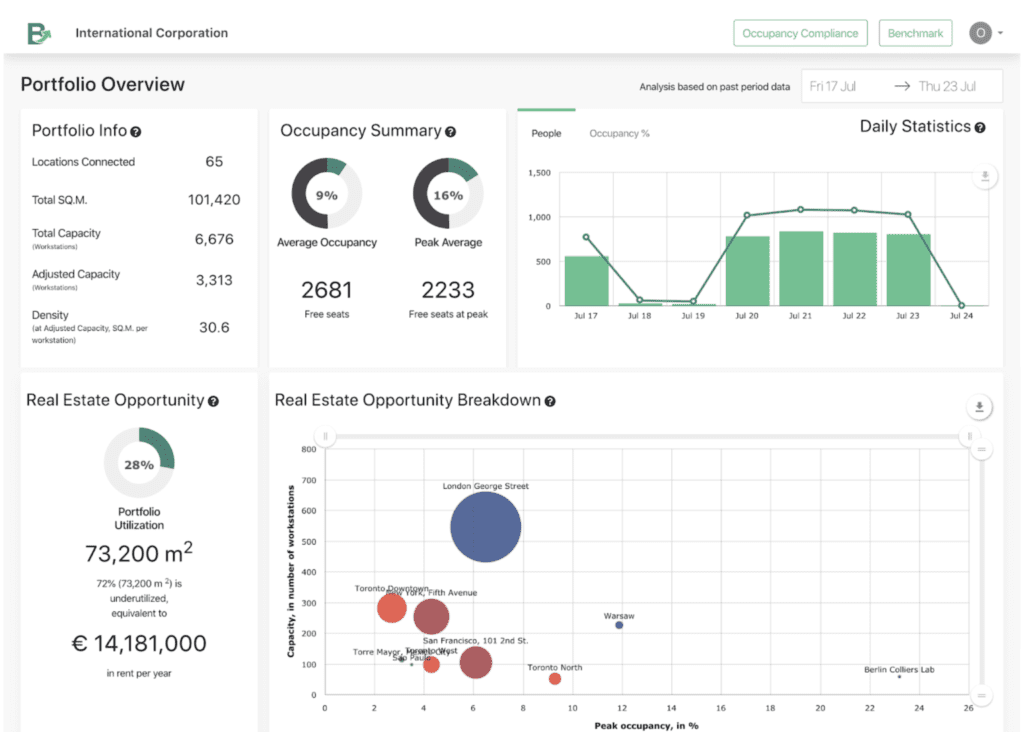Comfy’s partnership with Basking.io, a Berlin-based workplace occupancy analytics platform, empowers Real Estate teams to visualize and understand real-time space utilization and density, so they can best adhere to local, physical distancing requirements. Comfy’s Safe Workplace package combined with occupancy insights gleaned from Basking’s quick-to-deploy solution enable customers to better monitor the effectiveness of their return to the workplace initiatives, at a portfolio-wide scale.
We spoke with Dr. Eldar Gizzatov, CEO and Co-founder of Basking, about WiFi analytics values in the COVID-era, the partnership with Comfy and more.
How does WiFi analytics work? What sort of data can you get from WiFi systems?
Basking is using a network-as-a-sensor approach. We’re connecting to the existing wireless infrastructure to get the required data about the location of devices connected to an office’s network. We’re then using our machine learning algorithms to convert this data into real estate metrics and workplace insights that are relevant for our customers – enterprise workplace and Real Estate managers.
Being based out of Europe, we’re focused on protecting the privacy of our clients’ employees. Basking is designed as a GDPR-native product from the start – the platform does not collect, store or process personal data. The only personal identifiable information (PII) that we collect is the MAC address of the device seen by the wireless network, and it is pseudonymised by Basking. It’s a very specific, and transparent set of data points that Basking is analyzing, which is great for privacy, data protection, and IT security – all extremely important for enterprise customers.
Why would a customer want to leverage WiFi Analytics for space utilization?
First of all it allows for a really fast deployment. If you’re optimizing for speed of connection to multiple locations across your office portfolio then a WiFi-based software approach is really the most viable option. We’re talking about several minutes or a couple of hours, depending on the WiFi vendor. Plus, with no additional hardware installation involved, the costs are obviously much lower. This solution is cost effective, at scale. Which is of course very important nowadays, as companies are adapting to COVID implications on their business.
Companies now understand they need to use occupancy analytics to adapt to work-from-home changes, and they want it to be done in a ROI focused way. You need to have good coverage across locations and understand what’s going on at the floor level. That’s required as a first step. You can then pinpoint some parts of the office where you really want to understand the occupancy in a granular way, with additional hardware involved.
What are some of the changes you’re seeing in the market around how customers are thinking about space analytics in the COVID era?
For companies working on bringing staff back to the office, the priority use cases right now are all about employee safety, social distancing, compliance, and tracing office-to-office visits – both mobility across the office’s location and across several offices. Basking enables all of these with WiFi-based features.
For example, if our client has a positive COVID case reported in one of the offices, they’re now able to understand the traffic from that site to other locations. This allows the company to proactively clean all the offices that could be affected. This tracing is only possible through WiFi analytics. Then you also have the understanding of the number of people in a certain area, understanding the density levels and the option to send real-time alerts for high-density events for office-specific stakeholders.
The other big change is obviously the work-from-home adoption and how it impacts the overall demand for the office space. Real Estate teams are reviewing the long term leases, planning for the capacity changes and increasing the overall flexibility of the portfolio. And of course the companies are looking at decreasing their Real Estate costs in the process.
Real Estate optimization was important before COVID, now it’s even more intense. People are not coming to the office in previous numbers. You need to adjust. The other side of that is the supply part of the equation. Due to social distancing requirements, you need to adjust your capacity. So more square feet per employee, per desk – it’s all changing the equation.
What does it take to go live with WiFi Analytics?
It’s important to note that we don’t deploy any software from Basking directly in the customer’s network. It’s all working through the WiFi vendors like Cisco, HPE Aruba. That’s a big plus for IT and security teams, because it’s a more secure way to receive data. Basking, as a service provider, is not able to change any internal settings on the network. We only receive data about a device’s location-wise behavior in the office.
With some vendors Basking takes minutes to install, as it’s just an API integration. At most maybe a couple of hours spent with the customer’s IT team. Then one of these deployments can scale to tens of buildings, hundreds of buildings.
What are some examples and use cases from your customers around leveraging WiFi analytics to help them streamline their Real Estate portfolios?
We’ve been working with Colliers International since 2019 globally, and Colliers is both a client and a partner. When deployed at Colliers’ European headquarters in London, Basking helped its Real Estate team to better understand how they could adapt to headcount growth. The number of employees was scheduled to grow quite significantly in London and Colliers were looking to rent additional office space adjacent to the existing building. Based on our analysis of space utilization metrics, we found that they were able to add about 150 more employees into the office without additional rent increase. This is a cost avoidance of about a million euros a year. That’s significant.
Most recently, as part of this relationship Basking has been deployed in 65 Colliers offices across North America, Latin America and Europe to track occupancy and social distancing compliance in real-time to support safe returns to the office, when employees choose to do so.





